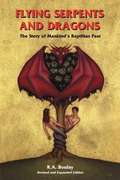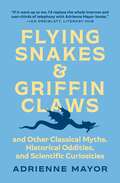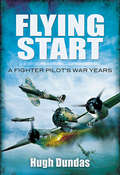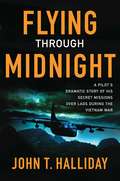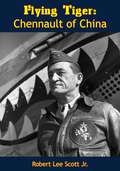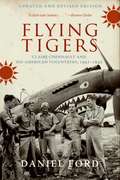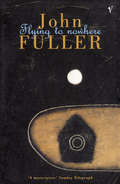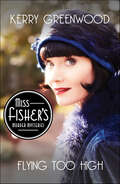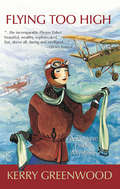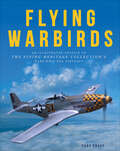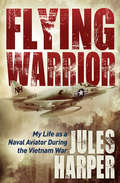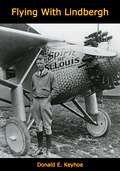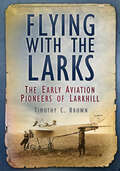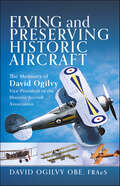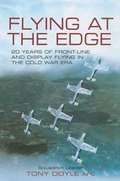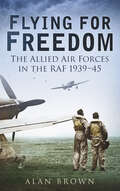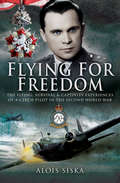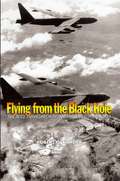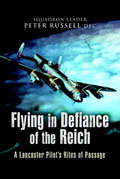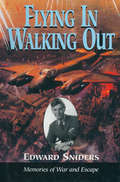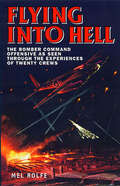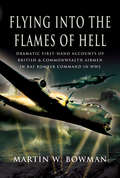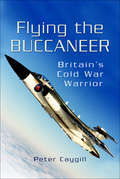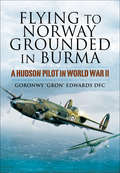- Table View
- List View
Flying Serpents and Dragons: The Story of Man's Reptilian Past
by R. A. BoulayWorld-wide legends refer to giant flying lizards and dragons which came to this planet and founded the ancient civilizations of Mesopotamia, Egypt, India and China. Who were these reptilian creatures? This book provides the answers to many of the riddles of history.
Flying Snakes and Griffin Claws: And Other Classical Myths, Historical Oddities, and Scientific Curiosities
by Adrienne MayorA treasury of astonishing mythic marvels—and the surprising truths behind themAdrienne Mayor is renowned for exploring the borders of history, science, archaeology, anthropology, and popular knowledge to find historical realities and scientific insights—glimmering, long-buried nuggets of truth—embedded in myth, legends, and folklore. Combing through ancient texts and obscure sources, she has spent decades prospecting for intriguing wonders and marvels, historical mysteries, diverting anecdotes, and hidden gems from ancient, medieval, and modern times. Flying Snakes and Griffin Claws is a treasury of fifty of her most amazing and amusing discoveries.The book explores such subjects as how mirages inspired legends of cities in the sky; the true identity of winged serpents in ancient Egypt; how ghost ships led to the discovery of the Gulf Stream; and the beauty secrets of ancient Amazons. Other pieces examine Arthur Conan Doyle’s sea serpent and Geronimo’s dragon; Flaubert’s obsession with ancient Carthage; ancient tattooing practices; and the strange relationship between wine goblets and women’s breasts since the times of Helen of Troy and Marie Antoinette. And there’s much, much more.Showcasing Mayor’s trademark passion not to demythologize myths, but to uncover the fascinating truths buried beneath them, Flying Snakes and Griffin Claws is a wonder cabinet of delightful curiosities.
Flying Start: A Fighter Pilot's War Years
by Hugh DundasThis is the autobiography of Group Captain Sir Hugh Dundas CBE, DSO, DFC, who was one of the most distinguished fighter pilots of World War II. He writes of his wartime experiences, and particularly of his period as Squadron Leader and Wing Commander and his involvement in the Battle of Britain.
Flying Through Midnight: A Pilot's Dramatic Story of His Secret Missions Over Laos During the Vietnam War
by John T. HallidayRiveting, novelistic, and startlingly candid, John T. Halliday's combat memoir begins in 1970, when Halliday has just landed in the middle of the Vietnam War, primed to begin his assignment with the 606th Special Operations Squadron. But there's a catch: He's stationed in a kind of no-man's-land. No one on his base flies with ID, patches, or rank. Even as Richard Nixon firmly denies reporters' charges that the United States has forces in Laos, Halliday realizes that from his base in Thailand, he will be flying top-secret, black-ops night missions over the Laotian Ho Chi Minh Trail. A naive yet thoughtful twenty-four-year-old, Halliday was utterly unprepared for the horrors of war. On his first mission, Halliday's C-123 aircraft dodges more than a thousand antiaircraft shells, and that is just the beginning. Nothing is as he expected -- not the operations, not the way his shell-shocked fellow pilots look and act, and certainly not the squadron's daredevil, seat-of-one's-pants approach to piloting. But before long, Halliday has become one of those seasoned and shell-shocked pilots, and finds himself in a desperate search for a way to elude certain death. Using frank, true-to-life dialogue, potent imagery, and classic 1970s song lyrics, Halliday deftly describes the fraught Laotian skies and re-creates his struggle to navigate the frustrating Air Force bureaucracy, the deprivations of a remote base far from home and his young wife, and his fight to preserve his sanity. The resulting nonfiction narrative vividly captures not only the intricate, distorted culture of war but also the essence of the Vietnam veteran's experience of this troubled era. A powerhouse fusion of pathos and humor, brutal realism and intimate reflection, Flying Through Midnight is a landmark contribution to war literature, revealing previously top-secret intelligence on the 606th's night missions. Fast-paced, thrilling, and bitingly intelligent, Halliday illuminates it all: the heart-pounding air battles, the close friendships, the crippling fear, and the astonishing final escape that made the telling of it possible.
Flying Through Midnight: A Pilot's Dramatic Story of His Secret Missions over Laos During the Vietnam War
by John T. HallidayRiveting, novelistic, and startlingly candid, John T. Halliday's combat memoir begins in 1970, when Halliday has just landed in the middle of the Vietnam War, primed to begin his assignment with the 606th Special Operations Squadron. But there's a catch: He's stationed in a kind of no-man's-land. No one on his base flies with ID, patches, or rank. Even as Richard Nixon firmly denies reporters' charges that the United States has forces in Laos, Halliday realizes that from his base in Thailand, he will be flying top-secret, black-ops night missions over the Laotian Ho Chi Minh Trail. A naive yet thoughtful twenty-four-year-old, Halliday was utterly unprepared for the horrors of war. On his first mission, Halliday's C-123 aircraft dodges more than a thousand antiaircraft shells, and that is just the beginning. Nothing is as he expected -- not the operations, not the way his shell-shocked fellow pilots look and act, and certainly not the squadron's daredevil, seat-of-one's-pants approach to piloting. But before long, Halliday has become one of those seasoned and shell-shocked pilots, and finds himself in a desperate search for a way to elude certain death. Using frank, true-to-life dialogue, potent imagery, and classic 1970s song lyrics, Halliday deftly describes the fraught Laotian skies and re-creates his struggle to navigate the frustrating Air Force bureaucracy, the deprivations of a remote base far from home and his young wife, and his fight to preserve his sanity. The resulting nonfiction narrative vividly captures not only the intricate, distorted culture of war but also the essence of the Vietnam veteran's experience of this troubled era. A powerhouse fusion of pathos and humor, brutal realism and intimate reflection, Flying Through Midnight is a landmark contribution to war literature, revealing previously top-secret intelligence on the 606th's night missions. Fast-paced, thrilling, and bitingly intelligent, Halliday illuminates it all: the heart-pounding air battles, the close friendships, the crippling fear, and the astonishing final escape that made the telling of it possible.
Flying Tiger: Chennault of China
by Robert Lee Scott Jr.Flying Tiger: Chennault of China by Robert Lee Scott, Jr. tells the story of a rebel whose concepts as to the use of air power often clashed with the orthodox and standardized teachings of the military schools of his time.
Flying Tigers
by Daniel FordDuring World War II, in the skies over Rangoon, Burma, a handful of American pilots met and bloodied the "Imperial Wild Eagles" of Japan and in turn won immortality as the Flying Tigers. One of America's most famous combat forces, the Tigers were recruited to defend beleaguered China for $600 a month and a bounty of $500 for each Japanese plane they shot down-fantastic money in an era when a Manhattan hotel room cost three dollars a night. To bring his prize-winning history of the American Volunteer Group up to date, Daniel Ford has completely rewritten his 1991 text, drawing on the most recent U.S., British, and Japanese scholarship. New material from AVG veterans-including Erik Shilling and Tex Hill-help fill out the story, along with newfound recollections from Japanese and New Zealand airmen. Ford also takes up the rumors that Royal Air Force pilots "sold" combat victories to the Flying Tigers in order to share in the bounties paid by the Chinese government. "Admirable," wrote Chennault biographer Martha Byrd of Ford's original text. "A readable book based on sound sources. Expect some surprises." Even more could that be said of this new and more complete edition.
Flying To Nowhere
by John FullerWINNER OF THE WHITBREAD PRIZE AND SHORTLISTED FOR THE BOOKER PRIZE.John Fuller's first novel opens with the arrival of church agent Vane on a remote Welsh island where he is to investigate the disappearance of pilgrims visiting its sacred well. While Vane looks for clues and corpses the local Abbot seaches for the location of the soul. Magical and poetic, Flying to Nowhere awakens our secret hopes and fears and our need to believe in miracles.
Flying Too High: A Phryne Fisher Mystery (16pt Large Print Edition) (Miss Fisher's Murder Mysteries #2)
by Kerry GreenwoodFrom the author of the bestselling Phryne Fisher Series comes Flying Too High, the next historical mystery featuring the unstoppable amateur sleuth Phryne Fisher. And this time around, she takes to the air…"...the incomparable Phryne Fisher...beautiful, wealthy, sophisticated, but, above all, daring and intelligent..."—Library JournalLooking for riveting historical mystery books? This is for you:Perfect for fans of Jacqueline Winspear and Dorothy SayersInspired the Netflix show Miss Fisher's Murder Mysteries, starring Essie DavisMovie Now Streaming on Acorn TVWalking the wings of a Tiger Moth plane in full flight would be more than enough excitement for most people, but not for the unflappable Phryne—amateur detective and woman of mystery, as delectable as the finest chocolate and as sharp as razor blades.In fact, the roaring 1920s' most talented and glamorous murder detective flies even higher here, handling a murder, a kidnapping, and the usual array of beautiful young men with style and consummate ease. A bit of a flight risk herself, she does it all before it's time to adjourn to the Queenscliff Hotel for breakfast. Whether she's flying planes, clearing a friend of homicide charges, or saving a child, Phryne does everything with the same dash and elan with which she drives her red Hispano-Suiza.
Flying Too High: A Phryne Fisher Mystery (Phryne Fisher #2)
by Kerry GreenwoodThe second in the classic Phryne Fisher series from Kerry Greenwood, featuring the irresistible heroine Phryne. Whether shes foiling kidnappers, seducing beautiful young men or simply deciding what to wear for dinner, Phryne handles everything with her inimitable panache and flair. Danger, excitement and love--this is how the glamorous Phryne Fisher is determined to live her life in her second enticing adventure. Walking the wings of a Tiger Moth plane in full flight ought to be enough excitement for most people, but not Phryne Fisher, amateur detective, woman of mystery, as delectable as the finest chocolate and as sharp as razor blades. In this, the second Phryne Fisher mystery, the 1920s' most talented and glamorous detective flies even higher, handling a murder, a kidnapping and the usual array of beautiful young men with style and consummate ease--and all before it's time to adjourn to the Queens cliff Hotel for breakfast. Whether she's flying planes, clearing a friend of homicide charges or saving a child from kidnapping, she handles everything with the same dash and elan with which she drives her red Hispano-Suiza.
Flying Warbirds: An Illustrated Profile of the Flying Heritage Collection's Rare WWII-Era Aircraft
by Cory GraffGet a comprehensive look at how World War II was fought from the air.Do you want to get an up-close look at some of the rarest airplanes in the world? Are you curious about combat aircraft from World War II? In deluxe hard-back volumes, Flying Warbirds brings U.S., British, German, Russian and Japanese fighting planes from the 1930s and 1940s together, complete with detailed photographs to delight every aeronautics connoisseur.The airplanes at the Flying Heritage Collection were created at a time when aeronautical discovery had evolved to aviation mastery. Finely crafted by distinguished design bureaus with the leading technologies of the 1930s and 1940s, the main emphasis of the collection includes combat aircraft from World War II.In 1998, Paul G. Allen began acquiring and preserving these iconic warriors and workhorses, many of which are the last of their kind. Allen's passion for aviation and history, and his awareness of the increasing rarity of original WWII aircraft, motivated him to restore these artifacts to the highest standard of authenticity.Periodically, one or more of the exhibits are temporarily absent to participate in an event, for maintenance, or for continuing restoration. Experience one of the world’s top airplane collections any time you like through Flying Warbirds.Photographs include cockpit shots, exterior museum shots, historic photographs, and breathtaking contemporary flying shots from photographers like award-winning John Dibbs. Flying Warbirds is the definitive guide to everything you want to know about this fascinating period in aeronautics and military history.
Flying Warrior: My Life as a Naval Aviator During the Vietnam War
by Jules HarperA Vietnam veteran takes you into the cockpit and shares true stories of his flying career in this compelling memoir. In this action-packed memoir, Jules Harper recounts the unique process of becoming a naval aviator, revealing his experiences as a brand new pilot in a combat squadron and, finally, a flying warrior. He survived two combat cruises aboard the aircraft carrier USS Kitty Hawk from 1966–1968, compiled 332 career carrier takeoffs and landings, and was shot at daily by enemy fire while completing 200 combat missions over Vietnam, and shares the views of the aviators who flew along with him on these missions while fighting this unpopular war. A recipient of the Distinguished Flying Cross, twenty-one Air Medals, and many other accolades, he offers readers a new understanding and appreciation of the warriors who protect not only their comrades in arms, but the defense of the nation as well.
Flying With Lindbergh
by Donald E. KeyhoeOriginally published in 1928, this is a biography of Colonel Charles Lindbergh (1902-1974), an aviation pioneer and hero of the times.Nicknamed “Slim,” “Lucky Lindy,” and “The Lone Eagle,” Charles Augustus Lindbergh (1902-1974) emerged from virtual obscurity in 1927, at the age of 25, as a U.S. Air Mail pilot to instantaneous world fame as the result of his Orteig Prize-winning solo nonstop flight from Roosevelt Field on Long Island, New York, to Le Bourget Field in Paris, France.He flew the distance of nearly 3,600 statute miles (5,800 km) in a single-seat, single-engine, purpose-built Ryan monoplane, Spirit of St. Louis and became the 19th person to make a Transatlantic flight, the first being the Transatlantic flight of Alcock and Brown from Newfoundland in 1919; however, Lindbergh’s flight was almost twice the distance. The record-setting flight took 33 1⁄2 hours and resulted in Lindbergh, a U.S. Army Air Corps Reserve officer, being awarded the nation’s highest military decoration, the Medal of Honor, for his historic exploit.Considered one of the most admired figures of his time, author Donald E. Keyhoe presents a clear picture of the life and times of this fascinating man.This work will catapult the reader into a feeling of journeying across the country with Lindbergh himself.
Flying With the Larks: The Early Aviation Pioneers of Larkhill
by Timothy C. BrownIn 1903 the Wright Brothers achieved their dream of powered flight and from then on man’s domination of the skies became a reality. The military potential of aircraft was obvious from the outset, first as a way of spying on the enemy with reconnaissance planes and balloons armed with early cameras, and then as a way of taking the battle into the skies, as planes became weapons of war. In Britain these early days of military aviation were pioneered by a group of enthusiastic civilians and military men who were based at Lark Hill, Wiltshire where the rolling plains became ideal flying grounds. Here, the first military aviation base came into existence. Flying with the Larks charts its early days and its influence on First World War aviation.
Flying and Preserving Historic Aircraft: The Memoirs of David Ogilvy OBE, Vice-President of the Historic Aircraft Association
by David Frederick OgilvyDavid Ogilvy has spent more than a full working life in aviation. As a schoolboy he was sent out with a bugle and binoculars to blow a warning if a V1 flying bomb appeared. Soon after this, he joined the Royal Air Force and served for six years as a pilot, flying types ranging from the Tiger Moth to the Mosquito and Meteor. As a civilian he spent fourteen years involved in pilot training and became Chief Instructor of the Air Schools group, with responsibility for three establishments. He was a keen display and racing pilot and competed in many events, flying several historic types. At an early age David realised the need for owners and operators of flyable pre-war machines to have a representative organization to look after their concerns and interests, so, in 1951, when 22 and still serving in the RAF, he was a co-founder of the Vintage Aeroplane Club. He was also a founding member, and now a Vice President, of the Historic Aircraft Association. In 1966 David was appointed general manager of the famous Shuttleworth Collection at Old Warden. During this time, he brought in several historic aircraft, including initiating the retrieval of a 1935 Hawker Hind from Afghanistan. He flew many of the Collection’s remarkable airplanes, organizing and participating in the displays. As well as outlining his remarkable career, the main focus of this book is on David Ogilvy's descriptions of many of the historic aircraft he helped rescue and preserve and what it was like to be at their controls. It therefore provides a unique compendium of the flying characteristics of a range of historic aircraft for one or two of which, he unashamedly admits, he is possibly the last man alive to have flown. Away from the cockpit, David has been associated with many organizations, including being a founder member of the UK Aircraft Owners and Pilots Association, serving for 45 years in the roles of editor, Executive Chairman and President. He is also President of today's Vintage Aircraft Club and is a Fellow of the Royal Aeronautical Society. David was awarded the OBE ‘for services to aviation’ in I996.
Flying at the Edge: 20 Years of Front-Line and Display Flying in the Cold War Era
by Tony DoyleA firsthand account of a twenty-year career as an RAF fighter pilot, instructor, aerobatic flyer, and squadron leader. Tony Doyle first flew in the CCF, where he completed a glider course and then a highly prized Flying Scholarship. This opened the way to joining the RAF and becoming an all-weather tactical fighter pilot flying de Havilland Vampires and Gloster Meteors. At this he excelled, and he was posted as a flying instructor and then Staff Instructor. This was the age when the Jet Provost was the standard training aircraft. In 1962, Doyle was selected to fly with the newly formed Red Pelicans aerobatic display team and honed his skills as a display pilot. He moved to RAF Valley as the new Folland Gnat was being introduced in the training role. This diminutive aircraft was somewhat of a breakthrough—and after several design problems were ironed out it proved a superb aircraft, fast and agile. The general public were eager to see this new RAF addition and Doyle became its display pilot, flying at open days throughout the UK and Europe. In 1964 he converted to the English Electric Lightning, Britain&’s one and only supersonic fighter, with a top speed in excess of Mach 2 and a ceiling of 50,000 feet. He was posted to Treble One Squadron at Wattisham in October 1964 as part of the Quick Reaction Alert force against potential Russian bomber attacks. Once again he became the Lightning&’s chosen low-level display pilot and demonstrated it at the 1965 Paris Air Show. Shortly after that, he was forced to eject over the North Cornish coast after an engine explosion caused the loss of elevator control. This fascinating account of front-line and display flying goes into considerable detail of the aerodynamic qualities, dangers, and advantages of the types flown—and recounts life-threatening incidents and successes that will educate anyone interested in flying at the very edge.
Flying for Freedom: The Allied Air Forces in the RAF 1939-45
by Alan BrownAfter the Dunkirk debacle in May 1940, Britain's primary weapon of defence was her air force. The exploits of the RAF's bomber crews and fighter pilots featured almost nightly on the radio and in the cinema newsreels; the men themselves were the objects of great admiration and respect. Yet, how many of these brave airmen were not British nationals? During the Second World War, exiled airmen from six occupied countries in Europe flew from British soil, fighting in or alongside the squadrons of the RAF; each had a burning desire to strike back at the cruel regime that had so ruthlessly crushed his homeland. At the political level, the exiled governments were keen for their country's active service arms to remain independent, but the RAF had different ideas. Many influential sections of the Air Ministry avoided making firm commitments to their allies and considered these new reinforcements to have been thrust upon them. This book explores these courageous and often undervalued men, who were caught up in a web of political argument.
Flying for Freedom: The Flying, Survival and Captivity Experiences of a Czech Pilot in the Second World War
by Alois SiskaAlois Siska was born in Czechoslovakia and learnt to fly. He escaped to the UK after the German invasion and joined the R.A.F. He describes his experiences flying Wellington bombers. In December 1943 he was shot down and he and surviving members of the crew were adrift in the North Sea for 7 days in appalling conditions. Picked up by the Germans he underwent surgery to his badly wounded legs and became a POW. He suffered at the hands of the Gestapo and was held in numerous camps including Colditz. His injuries were so extensive that he was put under the care of Archibald McIndoe. Siska chose to return to his native country to join their air force but fell foul of the Communist authorities. His persecution is described in the closing chapters. His rank was restored only in 1991 on the collapse of the Communist regime. Despite his injuries he remained active until 2003 when he died just short of his 90th birthday. He was as an active member of the Czech Ex-R.A.F. Association, the R.A.F. Benevolent Fund in his country, and the Sue Ryder Homes for which he raised considerable funds. His death was marked with a fly-past of the Czech Air Force and he was posthumously awarded the highest military decoration—The Order of the White Lion.
Flying from the Black Hole
by Robert O. HarderAir Force navigators and bombardiers have long labored under the shadow of pilots--their contributions undervalued, misunderstood, or simply unknown to the general public. This was especially the case with the non-pilot officer aircrew in the Vietnam and Cold War-era B-52 Stratofortress. Of the six people who operated the bomber, three wore navigator wings--two of those men were also bombardiers, the other an electronic warfare officer. Without the navigator-bombardiers in particular, executing the nuclear war strike plan or flying Southeast Asian conventional bombing sorties would have been impossible. This book reveals who these men were and what they did down in the "Black Hole," a story told by one of their own.
Flying in Defiance of the Reich: A Lancaster Pilot's Rites of Passage
by Peter RussellThis is the vivid memoir of a man who was twenty-one at the outbreak of World War II. Having joined the RAFVR before the war, he was mobilized in August 1939 and after training became operational on 233 Squadron Coastal Command flying Hudsons from Leuchars, Aldergrove and St Eval. After fourteen months he was rested and was tasked with training navigators for the impending enlargement of Bomber Command.In 1944 he joined 625 Squadron flying Lancasters over German targets and eventually took command of B Flight and was promoted Squadron Leader. His memories of the many raids, his crew and operational flying during this period until the end of the war are truly gripping. After the German capitulation, Peter joined Shield Force bound for the Far-east and the night bombing of Japan. However before they could become operational the atom bomb put an end to the war in that theater. His unit was redirected to relieve Hong Kong and the final chapters give a unique insight into how the Japanese garrison was replaced by British law and order. This was a purely land operation carried out by the RAF without the presence of the Army.
Flying in Walking Out: Memories of War and Escape (Soundings Ser.)
by Edward SnidersEdward Sniders'' experiences of World War Two make compelling reading. As a Mosquito pilot, he led a charmed life until his luck ran out in dramatic fashion.'
Flying into Hell: The Bomber Command Offensive as Seen Through the Experiences of Twenty Crews
by Mel RolfeVivid World War II stories of the brave men of Bomber Command and their adventures from the bestselling author of To Hell and Back and Hell on Earth. Mel Rolfe brings the reader real-life stories of bomber command at war with his new book Flying into Hell. A journalist by profession, Rolfe has conducted his interviews and prepared the stories in such a way as to take the reader into the events as they happened. To read these accounts is to step back into the war itself . . . Returning to a French village three years after baling out from a blazing bomber, a former rear gunner was shown the site of his supposed grave. He had been so badly burned a French doctor had left him alone in a graveyard to die. He met again the brave people who had looked after him until he was well enough to join a group walking to freedom across the Pyrenees. Other stories include a bomber that came down so low over the sea to escape ack-ack guns that it struck the water and managed to claw its way back up into the sky; the Lancaster pilot who wore Hermann Goering&’s Iron Cross around his neck as a lucky charm; a gunner incarcerated in Buchenwald; and a flight engineer who lost his fingers to frostbite after the bomber&’s rear door was blown open. Many of these stories demonstrate the amazing resilience of the human spirit, and the unwavering courage of the young men who helped bomb the enemy into submission. They are illustrated with photographs, most of which have not been published before.
Flying into the Flames of Hell: Dramatic First-Hand Accounts of British & Commonwealth Airmen in RAF Bomber Command in WW2
by Martin W. BowmanThe book contains twenty-three stirring accounts of what life flying as air-crew in World War Two was really like. The writers are a mixed bunch of pilots, navigators and gunners who flew medium and heavy bombers or Mosquitoes. It conveys the terror of being coned by German searchlights over the target, attacks by Luftwaffe night-fighters, catastrophic damage to aircraft and the ensuing struggle to keep the machine airborne on the return trip to base. It tells of the comradeship between the crew and often the humor between them which was often bred from fear.The gentle and unassuming narratives convey the sense of purpose that these men felt in doing one of the most dangerous jobs in the war. It is a fitting tribute to those that survived and the many thousands who died in the struggle against Hitler's dreadful ambitions in Europe.
Flying the Buccaneer: Britain's Cold War Warrior
by Peter CaygillOriginally conceived as a carrier-born maritime attack aircraft, the Blackburn design included many original features such as Boundary Layer Control, a system which blew hot air over the flying surfaces to increase lift when landing.
Flying to Norway, Grounded in Burma: A Hudson Pilot in World War II
by Goronwy ‘Gron’ EdwardsA Royal Air Force pilot recounts his experiences on the front lines of WWII in both Europe and the Pacific in this fascinating military memoir. In 1936, Goronwy &“Gron&” Edwards joined the Royal Air Force on a Short Service Commission. After gaining his wings, he joined No. 233 General Reconnaissance Squadron and flew the Avro Anson, a hastily modified twin-engine aircraft. He later flew the Lockheed Hudson on reconnaissance patrols along the Norwegian coast. Searching for German capital ships hiding in the Fiords, Edwards also came up against Luftwaffe seaplanes—and won a Distinguished Flying Crossed for his valor during the Norwegian campaign. After becoming short-sighted and night-blind, Edwards was posted to the Navigational School at Cranage in Cheshire before qualifying as a Specialist Armament Officer. In September of 1944, he traveled to Maniur, India, where he became the Armament Officer of No. 221 Group. With the Japanese in retreat the group moved to Burma, where Edwards commanded the RAF advance party.
